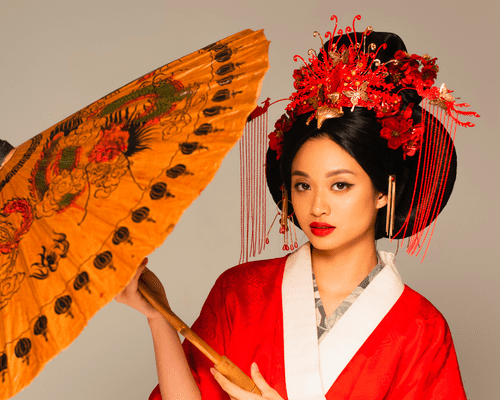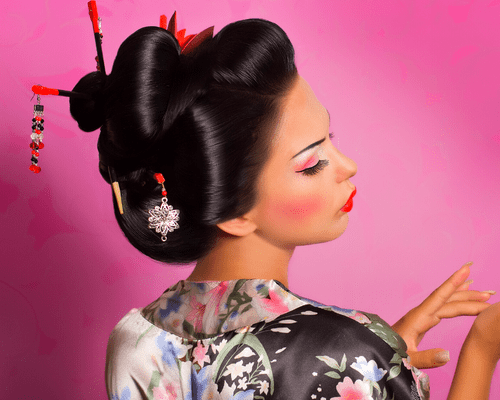On a hot summer’s day, having your hair on your face can be pretty distracting, especially when you forget your hair tie at home.
But good thing you find a pencil nearby that will help keep your hair up. So then you remember ancient Chinese paintings where you see women having hair sticks on their strands, and it got you curious.
What are those hair sticks called? And where did hair sticks originate?
In several cultures, hair sticks signify a deeper meaning than the latest trend or costume, so it’s essential to know its roots.
This article will guide you to learn more about hair sticks, so read more below.
Hair sticks history

Hair sticks are long and pointed accessories for holding and styling your hair.
Nowadays, you see them in various styles and colors online or at your local beauty store.
But if you look through historical art, you’ll see various women wearing these lavish hair accessories. So who invented hair sticks in the first place?
Archaeological studies show that hair sticks were prominent in ancient Greek, Roman, Egyptian, and Chinese cultures. But earliest forms were also found depicted on Venus of Willendorf, an ancient sculpture that dates back to 30,000 BCE.
It’s believed that the prehistoric civilization used hair sticks made out of wood and bone to tidy up their hair. But over the years, several cultures have adapted hair sticks and evolved them to contain luxurious materials, like gold and gemstones.
So aside from being a hair ornament, what do hair sticks symbolize?
Hair sticks in Chinese culture
When you think about a traditional Chinese hairstyle, hair sticks are usually the first thing that comes to mind. So are hair sticks Chinese?
The habit of wearing hair sticks in Chinese culture dates back to the Neolithic era when they were useful for keeping your hair in place. But as time went on, the simple accessory became a deeper symbol.
So what do Chinese hair sticks represent?
In ancient Chinese culture, when a girl reached the age of 15, putting their hair up with a hair stick was part of their Coming of Age Ceremony to symbolize their readiness for marriage. Hair sticks then had flowers and animals at the ends and consisted of bone, wood, jade, silver, or gold.
It was only until the Han dynasty that hair sticks became exclusive to noblewomen from royal families.
It became a symbol of status, and the Emperor was well known to give hair sticks as gifts to his officials.
Since only the elite could wear them, hair stick designs became more elaborate and ornate. Aside from containing gold, silver, or agate, they were also bejeweled with precious gemstones.
Currently, hair sticks are still popular in China to wear during celebrations and festivals, but unlike in the Han dynasty, they are now more accessible to the masses.
Hair sticks in Japanese culture

If you’re in Japan, you may spot a few floral hair sticks worn along with traditional kimono attire.
Like the Chinese, the Japanese also consider hair sticks an integral part of their culture.
So what is a Japanese hair stick called?
The Japanese call hair sticks kanzashi. Women originally wore them as talismans to ward off evil spirits, so they had simpler designs. But because of the Chinese, the kanzashi then slowly became a fashion accessory.
The kanzashi became widespread during the Edo period, and more styles began to pop up. Hana, Bira-Bira, Ogi, and Kanoko dome are a few of the types of kanzashi, with Hana being the most popular as it consists of flowers depending on the month.
In the 80s, the art of making kanzashi became a profession where artists would take 5-10 years of training to master the skill.
Currently, only traditional brides, geishas, and maikos wear kanzashi, but younger generations now have taken up an interest in making them because of social media.
Hair sticks in African culture
Since hair sticks are handy tools for pinning and adorning your hair, it’s no wonder that African culture also has its own version and tradition for it.
So what are African hair sticks called?
There is no recorded history of what Africans call hair sticks, but some refer to them as bodkins or hairpins.
But when did Africans start wearing hair sticks?
It’s hard to pinpoint when Africans actually start wearing hair sticks, but they use them daily to keep hair out of their face and accessorize during celebrations. African hair sticks consist of wood, gold, copper, ivory, or bone, and some have embellishments of beads, jewels, and metal.
At a certain age, African girls will also receive hair sticks from their mothers or grandmothers to signify adulthood. In certain parts of the continent, hair sticks are usually worn in 2-3 sets as some deem wearing only 1 set as unacceptable.
You can still see hair sticks around Africa as souvenirs, but higher-quality ones are from skilled crafters, so they’re more valuable.
What culture puts chopsticks in hair?
It’s easy to mistake hair sticks for chopsticks because of their similar shape, but they’re actually different tools with different uses.
Hair sticks vs chopsticks
As discussed above, many cultures use hair sticks to hold and decorate their hair to honor their tradition.
But several companies produce hair sticks that closely resemble chopsticks and market them as the latest fashion trend. Some celebrities even wear chopsticks to depict “traditional Chinese fashion” as part of their costume.
So is it disrespectful to wear chopsticks in your hair?
Yes, it is disrespectful to Asian communities to wear chopsticks in your hair because they’re not meant as hair ornaments. Chopsticks are tools for eating, so it’s rude to use them for styling your hair.
If you want to put your hair up, you can use hair sticks, but never substitute them for chopsticks. So if you see a store advertise hair sticks as “hair chopsticks”, it’s best to run far away.
Are hair sticks cultural appropriation?
Wearing hair sticks is alright as long as you don’t use them to appropriate or make fun of other cultures.
They’re available in different styles or forms, so make sure not to pick up any that closely resembles chopsticks or anything that stereotypes other cultures.
If it’s accessible, you can also purchase hair sticks from artists specializing in them. They’re pricier, but they have better quality, so they’re sure to last a long time.
If you can’t find any hair sticks, never use chopsticks to hold up your hair but use a pen or pencil instead.
Are hair sticks good for your hair?

If you’re considering investing in a couple of hair sticks, the great thing about them is that you won’t need additional clips or hairsprays to keep your hair in place.
All you need is 1or 2 sticks, depending on the hairstyle you’re going for. Since they’re not tight like hair ties, hair sticks won’t leave a crease if you leave your hair up the entire day.
But once you do remove them, they won’t break the mid-lengths of your hair since they easily slide off. Just make sure to pick ones with a smooth surface so they won’t be rough on your hair.
If you have wavy or curly hair, you won’t need to straighten them since hair sticks will hold better because of your hair’s natural texture.
How to use hair sticks (long hair)
The easiest way to use hair sticks on long hair is to put it in a bun.
All you need to do is twist all of your hair and coil the lengths to create a bun. Gently weave your hair stick through layers of your hair, making sure it’s close to your scalp, so your bun remains secure.
You can then loosen up a few tendrils of hair if you want a more relaxed look.
Another stylish way to use a hair stick is to do a braided ponytail.
To start, gather all your hair at the back of your head and divide it into 2 sections. Braid 1 section and tie it around the other section to create a ponytail.
Then, coil the extra length of the braid to create a bun and use the hair stick to secure the hairstyle.
How to use hair sticks (short hair)
If you have shoulder-length hair, you can use a hair stick to secure it in a bun.
One way is to do a modified French twist by gathering all your hair at the back and twisting it towards your head.
Make sure to tuck your ends under the twist, then grab your hair stick and insert it in the middle of the twist, with the bottom facing up.
Then gently rotate the stick over the top of the twist until it’s right side up and bury it deeper down your hair.
If your hair is not long enough to create a bun, you can do a half bun instead.
The method is similar to doing a bun, but you’ll only need to gather the hair above your ears.
Where to find the best hair sticks?
Now that you know how versatile hair sticks can be, your only dilemma is where to find the perfect ones ideal for your hair.
SAYA Designs has a variety of wooden hair sticks that are great for short or medium hair. They’re lighter than typical hair sticks, so they won’t strain your hair if you wear them up all day. Their minimal wood design is also gentle on your hair, so if you want to avoid hair breakage, these might be the ones for you.
Yun Boutique also has several Chinese wooden hair sticks. They’re pricier, but they’re perfect for an elegant event as they’re gold/silver-plated and embellished with fresh-water pearls.
But if you’re looking for hair sticks for buns that you can wear daily, Etsy has a wide array of selections in any material that you can think of. Whether you want wood, stainless steel, acetate, or acrylic, they have several designs suitable for any budget.
Amazon also has a few choices of hair sticks with chains, so you can select between gold or silver hair sticks at an affordable price.
Final thoughts
At a glance, hair sticks may be a convenient and fun accessory to style your hair, but it’s important to know their roots since several cultures have a rich history connected to them.
So if you want to wear hair sticks, make sure you’re not wearing them with ill intentions towards other cultures. Wearing chopsticks on your hair is not the best way to portray traditional Chinese attire, so make sure you do your research if you want to honor Chinese culture properly.
There are plenty of hair stick styles that do not associate with Asian culture, so they’re best for daily wear without having to offend anybody.

